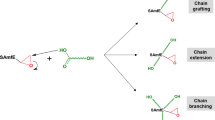Abstract
The potential for differential scanning calorimetry (DSC) as a tool for the discrimination of forensic polymer specimens is investigated for a series of commercial low density polyethylene (LDPE) samples. Variation in the melting temperatures of ‘as received’ samples was found to be too small for its use in sample discrimination. The melting behaviour of thermally treated samples, quenched from the melt in liquid nitrogen followed by annealing at temperatures below the melting temperature, showed promise in discrimination potential. The application of principal component analysis to aid discrimination demonstrated the necessity in using a controlled thermal history to aid the discrimination process. The clustering of the LDPEs based on the factors selected demonstrated the potential of DSC for the discrimination of forensic LDPE samples.




Similar content being viewed by others
References
Causin V, Marega C, Carresi P, Schiavone S, Marigo A. A quantitative differentiation method for plastic bags by infrared spectroscopy, thickness measurement and differential scanning calorimetry for tracing the source of illegal drugs. Forensic Sci Int. 2006;164:148–54.
Tsukame T, Kutsuzawa M, Sekine H, Saitoh H, Shibasaki Y. Identification of polyethylene by differential scanning calorimetry: application to forensic science. J Therm Anal Calorim. 1999;57:847–51.
Causin V. Polymers on the crime scene: how can analytical chemistry help to exploit the information from these mute witnesses? Anal Methods. 2010;2(7):777–980.
Muller AJ, Arnal ML. Thermal fractionation of polymers. Prog Polym Sci. 2005;30:559–603.
Sajwan M, Aggarwal S, Singh RB. Forensic characterization of HDPE pipes by DSC. Forensic Sci Int. 2008;175:130–3.
Hughs J, Shanks R, Cerezo F. Characterisation of the comonomer composition and distribution of the copolymers using chemometric techniques. J Therm Anal Calorim. 2004;76:1069–78.
Keating M, Lee I-H, Wong CS. Thermal fractionation of ethylene polymers in packaging applications. Thermochim Acta. 1996;284:47–56.
Author information
Authors and Affiliations
Corresponding author
Rights and permissions
About this article
Cite this article
Yang, L., Thomas, P. & Stuart, B. Discrimination of thermally treated low density polyethylenes using DSC and principal component analysis. J Therm Anal Calorim 108, 445–448 (2012). https://doi.org/10.1007/s10973-011-1946-2
Published:
Issue Date:
DOI: https://doi.org/10.1007/s10973-011-1946-2



